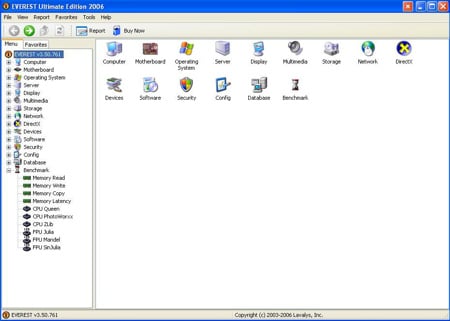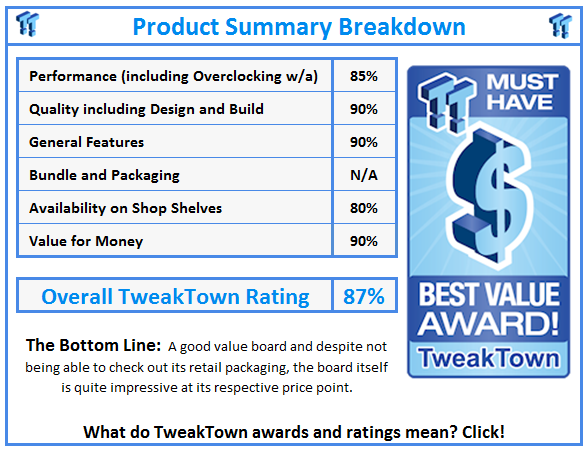Introduction

AM3 has never looked so good. With support for both DDR2 and DDR3 on the same CPU, the possibilities with this platform are endless. We have already seen quite a few good boards come out, either supporting one or the other technology and some with both. But one thing remains constant; a good price and a pretty good performing board and CPU combo for the outlay.
Just recently we took a look at the little brother of today's candidate from GIGABYTE; this new one is based on DDR3 memory and the 790FX chipset. Coning in at 179.99 U.S. Dollars over at Newegg, it's a bit higher priced than most. But can it handle the pressure? Let's see how it goes.
The Motherboard
The Board
Unfortunately with this board GIGABYTE didn't provide us a retail package for us to review, so we skipped straight onto the board itself. GIGABYTE uses the same large ATX PCB that we know and love; a blue base with 6 layers on a 30x24cm size. The layout itself is extremely neat.
The 24-pin power connector, IDE and FDD connector are located behind the four DDR3 memory slots, with the 4/8 pin EPS connector behind the PS/2 tower ports on the left hand side.
The CPU is fed its power through a 10 phase voltage system; eight go to the CPU core, while the other two run the memory controller and integrated CPU northbridge for a more stable power supply. The Mosfets are cooled by a large pipe assembly that surprisingly doesn't get in the way of any large aftermarket heatsinks. The heatpipe also cools the 790FX Northbridge and the SB.
On the right hand edge of the board GIGABYTE places its mass storage connectors. There are a total of 10 SATA ports; six blue ones which are run off the SB750 and four white ones running off two Jmicron based SATA controllers in GIGABYTE's backup RAID array.
Moving along to the rear I/O connectors, GIGABYTE uses the same port layout as we have seen for the DQ6 line of boards. There are no additional extras, just the same port config which is extremely good for uniformity.
Lastly, we are on expansion slots. Thanks to the 790FX chipset this board gets two PCIe x16 slots at full speed; that's 32 lanes dedicated just for graphics. GIGABYTE has taken advantage of this and places two blue graphics card slots for CrossfireX setups. Unfortunately AMD doesn't have SLI licensing, so no SLI setups here guys. Three PCIe x1 slots and two PCI slots make up the final arrangement.
Test System Setup and Memory Performance
Test System
Processor: AMD Phenom II x4 810 (13x 200MHz)
Memory: 2x 2GB DDR3-1600 Corsair Dominator (Supplied by Corsair)
Hard Disk: Intel X25-M 80GB SSD (Supplied by Intel)
Graphics Card: GIGABYTE 9800GX2 1GB (Supplied by GIGABYTE)
Cooling: GIGABYTE 3D Galaxy II Water cooling
Operating System: Microsoft Windows Vista X64 SP1
Drivers: Intel INF 9.0.0.1008, ForceWare 180.24
Unfortunately with this board we were quite rushed and didn't get a chance to take our usual BIOS screen shots or CPU-Z screenshot. For this we are very sorry. However, we didn't break any speed barriers with this board and a limit of 226MHz FSB was as good as it got.
On to testing and today we compare using ASUS' 790FX based board. Both boards were run with our usual tests at stock and overclocked speeds.
EVEREST Ultimate Edition
Version and / or Patch Used: 2006
Developer Homepage: http://www.lavalys.com
Product Homepage: http://www.lavalys.com
Buy It Here

EVEREST Ultimate Edition is an industry leading system diagnostics and benchmarking solution for enthusiasts PC users, based on the award-winning EVEREST Technology. During system optimizations and tweaking it provides essential system and overclock information, advanced hardware monitoring and diagnostics capabilities to check the effects of the applied settings. CPU, FPU and memory benchmarks are available to measure the actual system performance and compare it to previous states or other systems.

First off, we see that the platforms remain equal across stock tests, but when we overclock ASUS manages to pull slightly ahead.
Benchmarks - PCMark Vantage
PCMark Vantage
Version and / or Patch Used: Unpatched
Developer Homepage: http://www.futuremark.com
Product Homepage: http://www.futuremark.com/benchmarks/pcmark-vantage//
Buy It Here

PCMark Vantage is the first objective hardware performance benchmark for PCs running 32 and 64 bit versions of Microsoft Windows Vista. PCMark Vantage is perfectly suited for benchmarking any type of Microsoft Windows Vista PC from multimedia home entertainment systems and laptops to dedicated workstations and high-end gaming rigs. Regardless of whether the benchmarker is an artist or an IT Professional, PCMark Vantage shows the user where their system soars or falls flat, and how to get the most performance possible out of their hardware. PCMark Vantage is easy enough for even the most casual enthusiast to use yet supports in-depth, professional industry grade testing.

Moving along to the synthetic tests, we see that the ASUS and GIGABYTE boards are equal at stock. However, ASUS manages to pull ahead at the overclocked level, but only just.
Benchmarks - SYSmark 2007 Preview
SYSmark 2007
Version and / or Patch Used: 1.04
Developer Homepage: http://www.bapco.com/
Product Homepage: http://www.bapco.com/products/sysmark2007preview/>

SYSmark 2007 Preview is the latest version of the premier performance metric that measures and compares PC performance based on real world applications.
SYSmark 2007 Preview extends the SYSmark family, which has been widely accepted by IT Managers, PC OEMs, press and analysts worldwide to support Windows Vista™.
SYSmark 2007 Preview allows users to directly compare platforms based on Windows Vista™ to those based on Windows XP Professional and Home.
The new release also incorporates numerous new features and enhancements such as an improved GUI allowing streamlined start-up and run along with a heads-up-display (HUD) and automated error reporting.
SYSmark 2007 Preview is an application-based benchmark that reflects usage patterns of business users in the areas of Video creation, E-learning, 3D Modeling and Office Productivity. This new release includes a robust and refreshed set of applications.

A similar trend is seen in SYSmark 2007, but this is based in the real world application field. ASUS still only wins at the overclocking level.
Benchmarks - 3DMark Vantage
3DMark Vantage
Version and / or Patch Used: 1.01
Developer Homepage: http://www.futuremark.com
Product Homepage: http://www.futuremark.com/products/3dmarkvantage/
Buy It Here

3DMark Vantage is the new industry standard PC gaming performance benchmark from Futuremark, newly designed for Windows Vista and DirectX10. It includes two new graphics tests, two new CPU tests, several new feature tests, and support for the latest hardware.
3DMark Vantage is based on a completely new rendering engine, developed specifically to take full advantage of DirectX10, the new graphics API from Microsoft.

Under synthetic gaming we see that the increase in speed the ASUS board has in the synthetic system tests shows out here in the overclocking field.
Benchmarks - Crysis
Crysis
Version and / or Patch Used: 1.1
Timedemo or Level Used: Custom Timedemo
Developer Homepage: http://www.crytek.com/
Product Homepage: http://www.ea.com/crysis/
Buy It Here

From the makers of Far Cry, Crysis offers FPS fans the best-looking, most highly-evolving gameplay, requiring the player to use adaptive tactics and total customization of weapons and armor to survive in dynamic, hostile environments including Zero-G.
Real time editing, bump mapping, dynamic lights, network system, integrated physics system, shaders, shadows and a dynamic music system are just some of the state of-the-art features the CryENGINE™ 2 offers. The CryENGINE™ 2 comes complete with all of its internal tools and also includes the CryENGINE™ 2 Sandbox world editing system.

Lastly, we see that Crysis likes the increased speed of the ASUS board when overclocking, but GIGABYTE isn't that far behind.
Power Usage and Heat Tests
Power Consumption
We are now able to find out what kind of power is being used by our test system and the associated graphics cards installed. Keep in mind; it tests the complete system (minus LCD monitor, which is plugged directly into an AC wall socket).
There are a few important notes to remember though; while our maximum power is taken in 3DMark06 at the same exact point, we have seen in particular tests the power being drawn as much as 10% more. We test at the exact same stage every time; therefore tests should be very consistent and accurate.
The other thing to remember is that our test system is bare minimum - only a 7,200RPM SATA-II single hard drive is used without CD-ROM or many cooling fans.
So while the system might draw 400 watts in our test system, placing it into your own PC with a number of other items, the draw is going to be higher.

GIGABYTE manages to pull ahead when it comes to using less power, though ASUS is able to keep right on its heals.
Heat Generation
As a new measure, we are now monitoring the heat generation from the key components on the motherboards, this being the Northbridge, Southbridge (if it contains one) as well as the Mosfets around the CPU. The results are recorded at idle and load during the power consumption tests.

ASUS and GIGABYTE produce about the same amount of heat.
Final Thoughts
While everyone is pushing for Intel with their enthusiast level platforms, AMD still has a very good place for a more budget conscious CPU with a good kick and it's good to see that good quality boards are still coming out consistently for them. GIGABYTE has always been a good AMD partner and the 790FXT is another one of their long running high quality boards.
The features of the board are extremely impressive, as is the performance. Overclocking on AMD needs a bit more tweaking, but we are seeing things getting better with their upcoming CPUs.
In all, this board is a great choice for the price.








 United
States: Find other tech and computer products like this
over at
United
States: Find other tech and computer products like this
over at  United
Kingdom: Find other tech and computer products like this
over at
United
Kingdom: Find other tech and computer products like this
over at  Australia:
Find other tech and computer products like this over at
Australia:
Find other tech and computer products like this over at  Canada:
Find other tech and computer products like this over at
Canada:
Find other tech and computer products like this over at  Deutschland:
Finde andere Technik- und Computerprodukte wie dieses auf
Deutschland:
Finde andere Technik- und Computerprodukte wie dieses auf